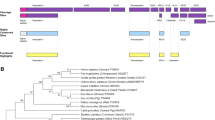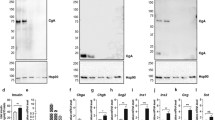Abstract
The rat brain- and pituitary-specific 1B1075 mRNA encodes a chromogranin/secretogranin-like protein, called secretogranin III (SgIII), that is a component of intracellular dense core vesicles. In order to study the function of this gene product in a mouse model system, we have isolated the murine homolog of the rat 1B1075 mRNA. This mRNA contains 2163 bp encoding a putative protein of 421 amino acids. Cleavage of the strong putative signal sequence would yield a mature protein of 51 kDa. The sequence of the encoded murine protein preserves the structural features that suggest SgIII is a member of the granin family, and allowed us to recognize and correct errors in our published rat sequence.
Similar content being viewed by others
References
Aviv H. and Leder P. (1972) Purification of biologically active globin messenger RNA by chromatography on oligothymidylic acid-cellulose.Proc. Natl. Acad. Sci. USA 69, 1408–1412.
Blatt C., Weiner L., Sutcliffe J. G., Nesbitt M. N., and Simon M. I. (1985) Chromosomal mapping of murine brain-specific genes.Cytogenet. Cell. Genet. 40, 583a.
Danielson P. E., Forss-Petter S., Brow, M. A., Calavetta L., Douglass J., Milner R., and Sutcliffe J. G. (1988) p1B15: a cDNA clone of the rat mRNA encoding cyclophilin.DNA 7, 261–267.
Eiden L. E. (1987) Is chromogranin a prohormone?Nature 325, 301.
Feinberg A. P. and Vogelstein B. (1983) A technique for radiolabeling DNA restriction endonuclease fragments to high specific activity.Anal. Biochem. 132, 6–13.
Forss-Petter S., Danielson P., Battenberg E., Bloom F., and Sutcliffe J. G. (1989) Nucleotide sequence and cellular distribution of rat chromogranin B (secretogranin I) mRNA in the neuroendocrine system.J. Mol. Neurosci. 1, 63–75.
Galindo E., Rill A., Bader M.-F., and Aunis D. (1991) Chromostatin, a 20-amino acid peptide derived from chromogranin A, inhibits chromaffin cell secretion.Proc. Natl. Acad. Sci. USA 88, 1426–1430.
Gerdes H.-H., Rosa P., Phillips E., Baeuerle P. A., Frank R., Argos P., and Huttner W. B. (1989) The primary structure of human secretogranin II, a widespread tyrosine-sulfated secretory granule protein that exhibits low pH- and calcium-induced aggregation.J. Biol. Chem. 264, 12,009–12,015.
Hogan B., Costantini F., and Lacy E. (1986)Manipulating the Mouse Embryo: A Laboratory Manual, Cold Spring Harbor Laboratory, Cold Spring Harbor, New York, pp. 153–186.
Huttner W. B. and Benedum U. M. (1987) Chromogranin A and pancreastatin.Nature 325, 305.
Huttner W. B., Gerdes H.-H., and Rosa P. (1991) The granin (chromogranin/secretogranin) family.TIBS 16, 27–30.
Iacangelo A. L., Fischer-Colbrie R., Koller K. J., Brownstein M. J., and Eiden L. E. (1988) The sequence of porcine chromogranin A messenger RNA demonstrates chromogranin A can serve as the precursor for the biologically active hormone, pancreastatin.Endocrinology 122, 2339–2342.
Kingsley D. M., Rinchick E. M., Russell L. B., Ottiger H.-P., Sutcliffe J. G., Copeland N. G., and Jenkins N. A. (1990) Genetic ablation of a mouse gene expressed specifically in brain.EMBO J. 9, 395–399.
Kirchmair R., Hogue-Angeletti R., Gutierrez J., Fische-Colbrie R., and Winkler H. (1993) Secretoneurin-A neuropeptide in brain, adrenal medulla and other endocrine tissues by proteolytic processing of secretogranin II (chromogranin C).Neuroscience 53, 359–365.
Konecki D. S., Benedum U. M., Gerdes H. H., and Huttner W. B. (1987) The primary structure of human chromogranin A and pancreastatin.J. Biol. Chem. 262, 17,026–17,030.
Maniatis T., Fritsch E. F., and Sambrook J. (1982)Molecular Cloning: A Laboratory Manual. Cold Spring Harbor Laboratory, Cold Spring Harbor, New York.
Maxam A. M. and Gilbert W. (1977) A new method of sequencing DNA.Proc. Natl. Acad. Sci. USA 74, 560–564.
Milner R. J. and Sutcliffe J. G. (1983) Gene expression in rat brain.Nucleic Acids Res. 11, 5497–5520.
Ottiger H.-P., Battenberg E. F., Tsou A.-P., Bloom F. E., and Sutcliffe J. G. (1990) A brain- and pituitary-specific mRNA that encodes a novel chromogranin/secretogranin-like component of intracellular vesicles.J. Neurosci. 10, 3135–3147.
Perlman D. and Halvorson H. O. (1983) A putative signal peptidase recognition site and sequence in eucaryotic and procaryotic signal peptides.J. Mol. Biol. 167, 391–409.
Rosa P., Hille A., Lee R. W. H., Zanini A., De Camilli P., and Huttner W. B. (1985) Secretogranins I and II: two tyrosine-sulfated secretory proteins common to a variety of cells secreting peptides by the regulated pathway.J. Cell. Biol. 101, 1999–2011.
Sanger F., Nicklen S., and Coulson A. R. (1977) DNA sequencing with chain terminating inhibitors.Proc. Natl. Acad. Sci. USA 74, 5463–5467.
Schibler K., Tosi M., Pittet A. C., Fabiani L., and Wellauer P. K. (1980) Tissue-specific expression of mouse a-amylase genes.J. Mol. Biol. 142, 93–116.
Schmidt W. E., Siegel E. G., Kratzin H., and Creutzfeldt W. (1988) Isolation and primary structure of tumor-derived peptides related to human pancreastatin and chromogranin A.Proc. Natl. Acad. Sci. USA 85, 8231–8235.
Seidah N. G., Hendy G. N., Hamelin J., Paquin J., Lazure C., Metters K. M., Rossier J., and Chretien M. (1987) Chromogranin A can act as a reversible processing enzyme inhibitor.FEBS Lett. 211, 144–150.
Simon J.-P., Bader M.-F., and Aunis D. (1988) Secretion from chromaffin cells is controlled by chromogranin A-derived peptides.Proc. Natl. Acad. Sci. USA 85, 1712–1716.
Tatemoto K., Efendic S., Mutt V., Makk G., Feistner G. J., and Barchas J. D. (1986) Pancreastatin, a novel pancreatic peptide that inhibits insulin secretion.Nature 324, 476–478.
Vaudry H. and Conlon J. M. (1991) Identification of a peptide arising from the specific post-translation processing of secretogranin II.Fed. Eur. Biochem. Soc. Lett. 284, 31–33.
VonHeijne G. (1986) A new method for predicting signal sequence cleavage sites.Nucleic Acids Res. 14, 4683–4690.
Wand G. S., Takiyyuddin M., O’Connor D. T., and Levine M. A. (1991) A proposed role for chromogranin A as a glucocorticoid-responsive autocrine inhibitor of proopiomelanocortin secretion.Endocrinology 128, 1345–1351.
Author information
Authors and Affiliations
Rights and permissions
About this article
Cite this article
Dopazo, A., Lovenberg, T.W., Danielson, P.E. et al. Primary structure of mouse secretogranin III and its absence from deficient mice. J Mol Neurosci 4, 225–233 (1993). https://doi.org/10.1007/BF02821554
Received:
Accepted:
Issue Date:
DOI: https://doi.org/10.1007/BF02821554




